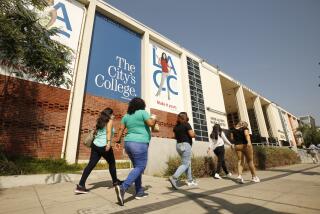Instructors Decry Report on Colleges
- Share via
When a much-touted state commission recently stated that California’s beleaguered community college system could find financial salvation by going high-tech and business lean, Martin Hittelman’s response was to scoff.
A faculty union leader and math instructor at Valley College in Van Nuys, Hittelman described an episode when he taught at Harbor College in Wilmington some years ago. The school managed to assemble a state-of-the-art video production facility, only to have cutbacks force the layoff of the technician who maintained it, he said. Without that support, the facility eventually fell into disuse and, finally, the college ended up turning over its video equipment to a cable television company.
The lesson for Hittelman was that high-tech gadgets alone serve little purpose unless colleges also can afford the other expenses that make learning possible for students.
Hittelman is hardly alone in his complaints about the report by the state-appointed Commission on Innovation. In fact, in the month since its release, prominent community college faculty leaders and administrators, often at odds elsewhere, have branded many of the report’s recommendations unrealistic and rejected its key premise.
In essence, the 20-member panel concluded that California’s community colleges can offer a better education--with little more than current spending--by focusing on more televised classes, computer self-study centers and efficiency reforms.
But many faculty leaders and administrators in California’s community colleges--the world’s largest system of post-secondary education--argue that such high-tech programs are actually more expensive than current methods if highest standards are applied.
Additionally, they see see no solutions in the report for current funding shortages that have forced community colleges around the state to turn away students and struggle with outdated equipment and facilities.
“There has to be a parallel plan to deal with today,” said Dianne Van Hook, superintendent of the Santa Clarita Community College District and a leader in a statewide group of community college executives.
“We don’t think the ‘how tos’ in there are very realistic,” she said of the report. Although she lauded some of its goals, Van Hook said the recommendations lack “thoughtful consideration” of solving today’s problems.
“Basically, they don’t know what they’re talking about in terms of the day-to-day operations of the colleges,” said Hittelman, president of the Community College Council, the arm of the California Federation of Teachers, one of two major faculty union groups active at the state’s 107 community colleges.
Even more blunt was Regina Stanback-Stroud, president of the Academic Senate for California’s community colleges. “The report has gotten such negative criticism from almost everyone in the system, it’s an embarrassment. It’s considered to be worthless by many people,” said Stanback-Stroud, an instructor at Rancho Santiago College in Santa Ana.
Appointed by the Board of Governors of the California Community Colleges in November, 1991, the commission’s goal--in the words of its own report--”was to recommend how a better job could be done for more students--without relying on more funding” and whether “the remarkable productivity gains” of business could be applied to colleges.
The panel, funded by foundation grants, was headed by retired Southern California Edison Co. President Michael Peevey. Its members included Los Angeles Mayor Richard Riordan and former state Legislative Analyst A. Alan Post. The college system’s Board of Governors is scheduled to hold a Jan. 13 public hearing on the report.
The issue became so sensitive that when community college system Chancellor David Mertes briefed members of Congress on the report soon after its Oct. 27 release, the executive committee of the system’s Academic Senate asked him--without success--to stop presenting the plan outside the state until its ideas are adopted or rejected.
Without dramatic changes, current annual expenditures of about $3.6 billion on California community colleges will climb to $4.8 billion by 2005. In addition, there would be a demand for about $4 billion of new facilities during that period. The colleges’ 1.3 million student population is projected to grow by one-third over the coming decade.
Saying California’s economy would be hard-pressed to afford that bill, the report says its plan would limit the cost in 2005 to $3.9 billion.
Key recommendations include that colleges should provide 20% of their instruction through so-called distance learning methods such as televised courses by 2005, offer more courses in the now sparsely used afternoon periods and switch to year-round education. Unless they do, the report says, the state would withhold funding for new facilities.
The report also calls for a new system of standardized testing to determine whether students advance academically, providing more community college services to businesses to stimulate economic development, a broad program of deregulation of state and local administrative codes, and a switch to statewide collective bargaining for community college employees.
One of the most controversial proposals, to take remedial and English-as-a-second-language students out of the community college system and place them in separately funded “community academies,” was part of the report’s draft version, but was cut from the final version amid complaints the plan would create a “dumping ground” for poor and minority students.
Teachers and administrators said they do not have the money now to switch to year-round programs or offer afternoon classes. Some fear deregulation would mean an end to affirmative-action hiring programs and rules encouraging full-time faculty. And some question the report’s testing proposal, questioning whether keying teaching to such tests would enhance education.
The proposals for more televised courses and computer learning centers have drawn extensive debate and concerns that both could leave students on their own without the support from faculty and other students that many consider key to successful learning. Critics fear a low-budget system of little more than students watching videotaped sessions.
“Students don’t learn that way. They need people,” said Hittelman of Valley College. At his campus, meanwhile, where many students still are taught in post-World War II bungalows, college officials recently were excitedly discussing the impending arrival of their latest technical innovation: The college soon will be wired for cable TV.
More to Read
Sign up for Essential California
The most important California stories and recommendations in your inbox every morning.
You may occasionally receive promotional content from the Los Angeles Times.










